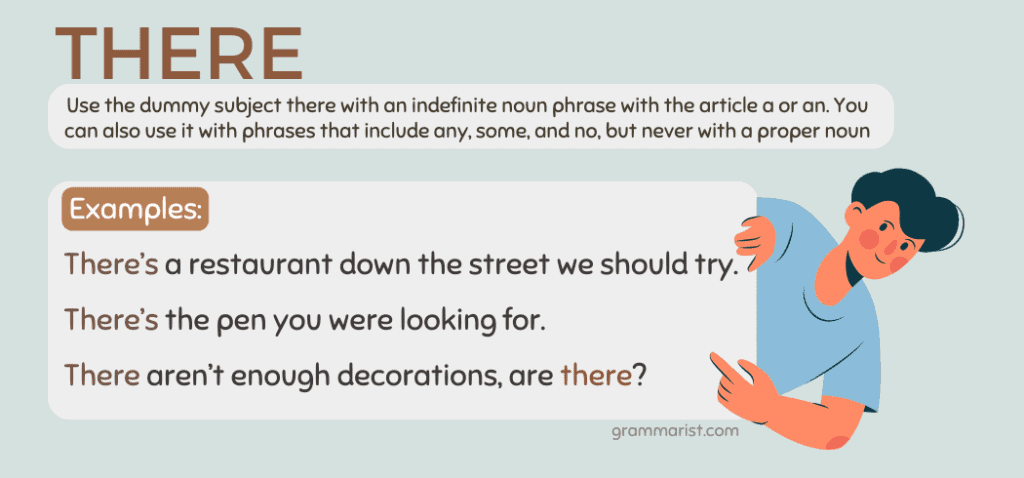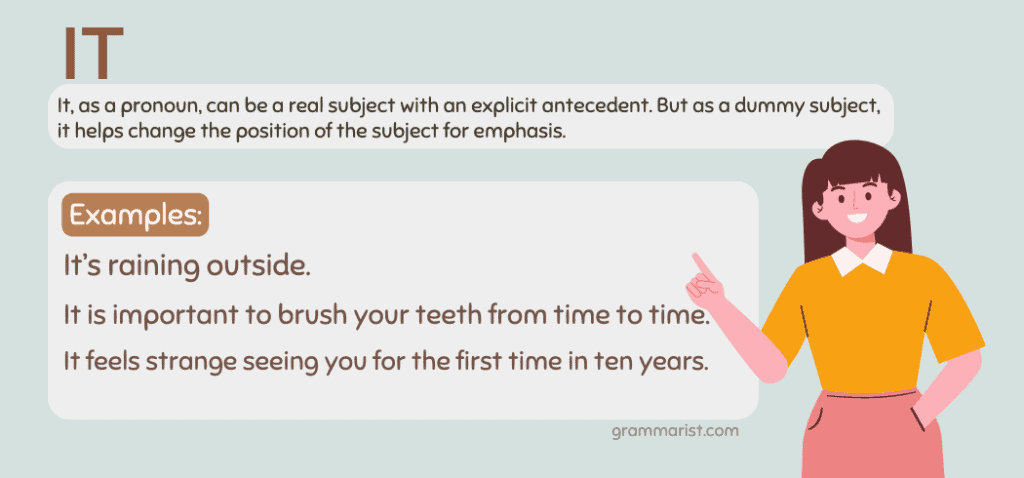I remember when we were taught that all sentences have subjects. However, sometimes these subjects only take up space without adding meaning to the statement.
The use of it and there as subjects only serves to fill the slot of a subject in sentences without one. They are called dummy subjects, which we will discuss in this article.
Keep reading to learn the difference between it and there. Then, answer the worksheet I provided to test your knowledge.
What Is a Dummy Subject?
Before understanding what a dummy subject is, let’s review the basic definition of a subject.
In English grammar, a subject is the one that does the action or is what the sentence is about. This part of the sentence usually precedes the verb. The subject can be a noun, noun phrase, verbal, or pronoun.
A dummy subject is a type of subject with no meaning. Its only purpose is to fill the position of the sentence’s subject while introducing time, weather, date references, and the situation in general.
“It” and “There” as Dummy Subjects
The two common dummy subjects are it and there. Many writers do not recommend using them in sentences. However, some sentences require this construction to emphasize the situation or condition. Consider the examples below.
- Poor: Some juice is left.
- Correct: There is some juice left.
The first sentence seems odd as it answers the question, what is left? But the second sentence shows the use of there as a dummy subject to highlight the existence of some juice. Technically, the subject is there. But some juice left is the more logical subject.
How to Use “There”

Use the dummy subject there with an indefinite noun phrase with the article a or an. Sometimes, the indefinite noun phrase has no article. You can also use it with phrases that include any, some, and no, but never with a proper noun. For example:
- There’s a restaurant down the street we should try.
In this sentence, there refers to an indefinite phrase, a restaurant down the street we should try.
We can also use there with definite noun phrases when suggesting alternative choices. For example:
- There’s the red handbag or the pink crossbody bag. Which one do you like?
In this sentence, the person listening knows both bags being discussed.
Another way to use there with definite noun phrases is when it means in that place. For example:
- There’s the pen you were looking for.
- There’s Samantha.
There is also used with question tags. For example:
- There aren’t enough decorations, are there?
There’s is a common contractionthat is only accepted in informal speech. The actual rule is to use there with a singular verb when it refers to a singular noun phrase and a plural verb with a plural noun phrase.
Here are more examples of there in sentences.
- There are three solutions to this problem.
- There’s a car waiting for you outside.
- There was a beautiful lady in the restaurant yesterday.
- There’s nothing you can do about it.
- There’s the snack I was looking for!
How to Use “It”

It, as a pronoun, can be a real subject with an explicit antecedent. But as a dummy subject, it helps change the position of the subject for emphasis. For example:
- It is important to brush your teeth from time to time.
Although the sentence structure dictates that it is the fake subject, the actual subject is the infinitive to brush your teeth daily. We can also rephrase this statement as:
- To brush your teeth from time to time is important.
- Brushing your teeth from time to time is important.
These two sentences show a clearer subject, to brush your teeth from time to time or brushing your teeth from time to time.
You may use this dummy subject in reference to time, dates, and weather. For example:
- It’s raining outside.
In this sentence, the real subject should be raining outside.
It can also be used with passive reporting verbs. Here’s an example in a sentence.
- It is believed that this building was once a hospital during the war.
The dummy subject it is also used when referring to general situations. For example:
- It’s Sasha who should come with you.
Here are more examples of it in sentences.
- It’s the fourth week of April today. We should start planning his birthday.
- It is cold in this state, even during summer.
- It’s funny how they disappear when you need them most.
- It’s getting cloudy, and we should stay inside.
- It feels strange seeing you for the first time in ten years.
- It’s a beautiful day to cook pancakes and sausages for breakfast.
Dummy Subjects: A Recap
English sentences always have subjects, and if there isn’t one, we can use the dummy subjects it and there. I hope this article has shown you the difference between it and there.
Remember what I said and use there when introducing new information, using definite noun phrases, and referring to in that place.
Use it as a dummy subject when referring to time, dates, weather, and general situations.